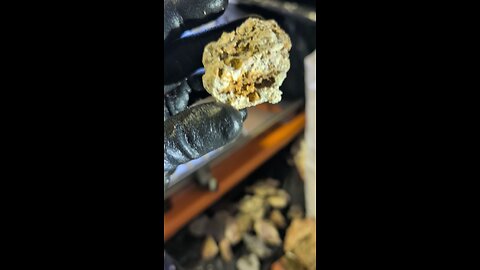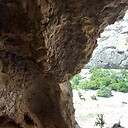
Travertine!
1 video
Updated 8 months ago
Travertine is a form of limestone deposited by mineral springs, especially hot springs. Here's an overview:
Formation:
Geological Process: Travertine forms from the precipitation of calcium carbonate from water flowing through limestone or from geothermal springs. As the water evaporates or loses carbon dioxide, calcium carbonate is left behind, creating travertine deposits.
Depositional Environments: Commonly found around hot springs, waterfalls, and in caves where groundwater rich in dissolved minerals emerges.
Characteristics:
Appearance: Travertine has a fibrous or concentric appearance and often shows a banded or layered structure. It can be found in various colors like white, tan, cream, and even rust-red if iron oxides are present.
Texture: It's known for its porous nature due to the presence of holes or cavities from gas bubbles or plant material during its formation. These cavities are often filled with a cementitious or resin-based filler to make it suitable for building and decorative purposes.
Durability: While not as hard as granite, travertine is still durable for many uses but requires sealing to prevent staining and wear, especially in high-traffic areas.
Uses:
Architectural:
Flooring: Popular for both indoor and outdoor floors due to its aesthetic appeal and slip-resistant texture when honed or tumbled.
Walls, Cladding: Used for both interior and exterior walls, offering a natural, elegant look.
Countertops: With proper sealing, it can be used for countertops, although it's less common due to its porosity.
Decorative: Travertine is also used for sculptures, fountains, and other decorative elements because of its workability and unique patterns.
Historical Uses: Travertine has been used since ancient times; for example, it was used extensively in Roman architecture, including the Colosseum in Rome.
Maintenance:
Sealing: Regular sealing is necessary to protect against stains and wear, especially if used in wet areas like bathrooms or kitchens.
Cleaning: Mild detergents or stone cleaners are recommended; harsh chemicals should be avoided to prevent damage.
Considerations:
Installation: Due to its natural variation, travertine should be laid out beforehand to ensure a pleasing pattern or color distribution.
Outdoor Use: While durable, it's sensitive to freeze-thaw cycles; in colder climates, care must be taken to prevent water from getting into its pores and freezing.
Travertine's natural beauty makes it a popular choice for both modern and traditional designs, but its maintenance requirements and the need for sealing should be considered when planning its use in various projects.
-
Travertine Cut!
 HumbleConservativeTravertine is indeed a type of limestone formed by mineral spring deposits, particularly from hot springs, which often results in a fibrous or banded appearance due to the deposition of calcium carbonate.57 views
HumbleConservativeTravertine is indeed a type of limestone formed by mineral spring deposits, particularly from hot springs, which often results in a fibrous or banded appearance due to the deposition of calcium carbonate.57 views